March 2024
March Means it's Time to Start Our Wednesday Evening Fun Runs Again!
Our first club Fun Run of the season will be Wednesday evening March 13th at The Dome Sports Bar & Grill, 1338 S. Commercial St, Neenah, with 5k and 10k route options leaving at 6:00 pm. This is after Daylight Savings Time begins, so we should have adequate evening light. After the run, there will be free tacos and beer. As always, all ages and abilities are welcome.
Mark Your Calendars For These Future Fun Runs:
- 4/17/24 The Grand Chute Community Center, 1850 Grand Chute Boulevard in Grand Chute
- 5/8/24 Fox West YMCA, W6931 School Road in Greenville
- 6/12/24 Whiting Boathouse, 98 5th Street in Neenah
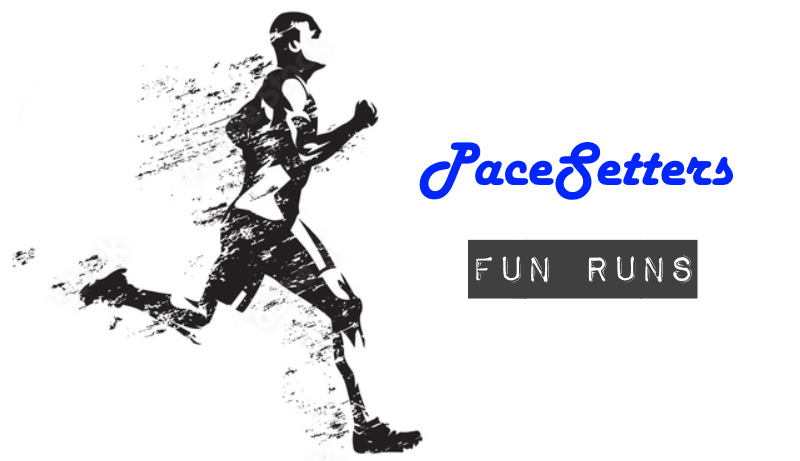
What is your favorite running book?
Last month we asked "What is your favorite Race Day Fuel"? And without further ado, you said:
Gu (vanilla, chocolate and undisclosed flavor), Maurten, Medjool dates stuffed with pistachio, base salt, honey sticks, pickles, oatmeal, Gatorade Fast Twitch
Two Wisconsin Athletes who competed at Olympic Marathon Trials in Orlando Last Month Give Exclusive Interviews to PaceSetters
Kathy VanDehy, 29, competed in the U.S. Olympic Marathon Trials in Orlando FL on February 3, 2024. She began running at a young age, running track and cross country in middle school and at Hortonville High School. At UW-Stevens Point she was a short sprinter focusing on the 400m and 800m distances. After leaving college she felt like she was no longer an athlete and now had more time to herself. Soon she became interested in marathons. She was accustomed to running 13 or 14 miles as part of her college training, so stretching that further and being able to complete the full marathon distance seemed a reasonable goal.
Kathy's first marathon was our local Community First Fox Cities Marathon in 2018 which she finished in 3:01 (some of you may remember her participating in our 2018 summer marathon training runs). At this point she was a marathon beginner and was “so new and naïve that I didn’t know if 3:01 was good or bad.” An experienced running friend of hers saw something in Kathy putting it in her mind that she could do something special with this. Kathy decided to get more serious about marathon running. The following year she won the Manitowoc Maritime Marathon in 2:50 and began working with a coach. At that point she only needed to shave 5 minutes from that time to qualify for the Olympic Trials so she knew she was getting close. Then Covid struck and, as many of us remember, all races shut down. When things resumed again, the qualifying standard for the 2024 Olympic Women Trials was lowered to 2:36. She was dedicated and worked hard. It was challenging getting her 80 to 130 miles per week in, she would start many of her runs at 3:30 or 4:00 am. The qualifying window opened up 1/1/2022, and Kathy was able to complete several qualifying marathons within that window. Two and a half years prepping for these Trials paid off and now it was off to Orlando!
It was “really cool and truly exclusive” staying at the host hotel with the other athletes. Kathy was treated like a true elite athlete. At one point she found herself alone on an elevator with the great Meb Keflezighi who gave her some wonderful words of encouragement.
Although Kathy had completed 11 marathons prior to Orlando, she knew this would be a different animal. Whereas most marathons are about pace, this one would be about place. “When running marathons, the mental piece is the biggest challenge, but you’re on the big stage now, the mental prep was different here. It wasn’t just another marathon, I had to be able to control my emotions. I couldn’t be stupid and run too fast off the line.” She was feeling good but yet realistic knowing that she couldn't run with the top women. “My PR was 2:29, some of the others had run 10 minutes faster.”
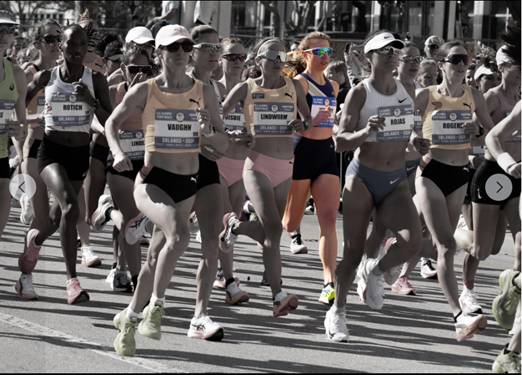
Kathy amongst many elite women near the start of 2024 U.S. Olympic Marathon Trials
The crowd was fantastic. “I normally don’t like a big race crowd because I find it distracting and it becomes harder to focus, but this was nice.” Kathy had about 15 friends and family members there and enjoyed seeing them multiple times around the looped course. The personal hydration stations were very coordinated, they had it down to a science. Her bottles were on Red Table #3 (red for women, blue for men), placement #2. Each of the 2 stations on the 8 mile loop had so many of these personal tables that they stretched on for a quarter mile or more. They also had 4 general hydration tables per loop with Maurten, regular and decaf, other electrolytes and cold wet sponges.
Kathy was holding on pretty close for the first 8 or 9 miles, but then was feeling the heat and felt like dropping out. “I was struggling bad.” The looped course made it challenging “seeing the finish line three times” but not yet being done. “But I owed it to myself to at least finish and realized I just needed to enjoy being out there.” She felt like she didn’t have a good run, finishing in 2:40. Although it was off her PR time and goal she had set for herself, she was 68th out of 117 women finishers, plus there were another 32 women who did not finish. In such a talented and deep field of elites under the heat of the Florida sun, this was a very impressive showing indeed.
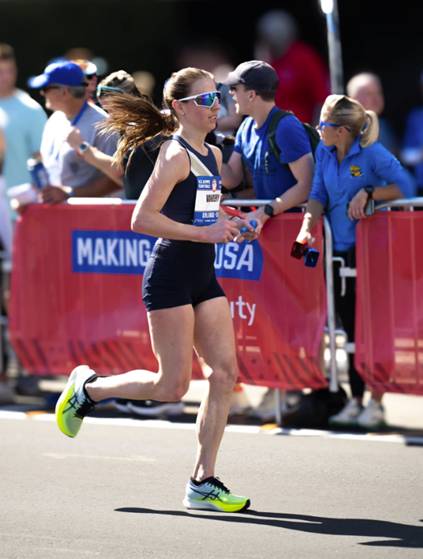
Kathy approaching finish line at 2024 U.S. Olympic Marathon Trials
After finishing, Kathy had the opportunity to speak with Master marathoner Dot McMahan (born in Hilbert, WI), who was running in her 4th Olympic Trials and finished just ahead of Kathy. She asked how Kathy’s run went and Kathy told her she was disappointed with her result. Dot said “Are you kidding? It’s crazy to think that you could come here and do as well as you did in your first Trials.” Hearing that brought Kathy ease and peace of mind.
Were there any takeaway lessons for Kathy? “Leading up to the race I constantly felt like I needed to do more, more miles, etc. What I didn’t really understand was to not do anything special, to stay consistent with what I had been doing. I didn’t self reflect very well, I thought I had to be perfect. I also need to be better next time at controlling my emotions at the start of the race. I was so tense the first couple of miles.” That is certainly a challenge given the enormity of this stage.
So what's next for Kathy? “I want to continue to be competitive with my running. I was a little sore after the race but, with all the training I did, my body is used to the pounding, so it’s not like how I felt after my first couple of marathons. I don’t know what the rest of 2024 will look like, I may race in some half marathons, 10k’s and 5k’s trying to set new PR’s and increase my speed.” She did say “at the next trials” so plan on hearing about Kathy again in 2028 and encourage her if you see her out on any training runs in our area and are able to keep anywhere close to her!
Dan Schubert, 30, formerly from Appleton WI and now residing in Durham, NC participated in the U.S. Olympic Marathon Trials in Orlando, FL on February 3, 2024. This had been a goal he thought about starting 12 years ago. Just to reach that stage was quite noteworthy as he needed to run a sub 2:18 at a certified marathon to be given this opportunity. He accomplished that with a 2:17:42 at the Indianapolis Monumental Marathon late this past October.
Dan has been accustomed to competitive running for much of his life. He was a successful cross country and track runner at Appleton East High School, earning him a scholarship to the University of Oklahoma where he continued to excel. Yet these Olympic trials were a whole new experience for him, on another level. This was a thrill for Dan to be in elite company with many of his idols, the greatest current set of marathoners in the U.S. The runners all stayed together in their own hotel where they were all treated as VIP’s having their needs catered to. Where else could you open a door and find Olympian Galen Rupp on the other side.
Being in this elite company made Dan think, “I’m a professional!” What a great feeling. But Dan also experienced some “Imposter Syndrome,” thinking what am I doing here and having some self doubt. His Indy Marathon last fall went “really, really well.” But that was the first and only previous marathon he had run, so he was a little naïve about how to follow that up. He didn’t really understand how much recovery time he would need. Whereas he had 16 great weeks of preparation for Indy, running about 70 miles per week, he then only had 12 weeks to get ready for Orlando. After Indy he “felt like rubble for a couple days” and was having some knee issues and body pains, so he didn’t have the same great workouts like he had going into Indy. And unlike some of the most elite runners in Orlando, Dan had a full time job to focus on, and a wife and family and friends that he enjoyed spending time with. He needed those mental breaks from his training and wasn’t going to give his whole lifestyle away. He had expectations for himself and wanted to be the absolute best that he could be at the Trials. But when his friends would seriously ask him if he was going to the Olympics he would realistically respond with a “No!”
With Dan’s past success and competitive nature, he would always find himself at or near the front at the starting line, at or near the front in the middle of the race, and at or near the front at the finish line. But here he was at the Olympic Trials starting line, lined up about 10 rows back. Unlike anything he had experienced before. Since there was so much ability with all of these athletes there was not the usual big separation that is usually seen at marathons. The bigger marathons might have 20 or 30 elite runners who break away at the start, here all 200 men were elites. Dan’s first mile was 5:30, so he could still see the front runners ahead who ran it in 5:00.
The company that coordinated the personal hydration program for all competitors was the second largest support effort they had ever done. There were 2 sets of hydration stations on the 8 mile loops, which the runners looped 3 times allowing them each to have 6 of their own bottles. Dan’s was at position 7 of 8 on Table #20. With 350 runners, that meant organizing 2,100 personal bottles. Dan also rubber banded Gu to his bottles to help him consume more electrolytes.
The race didn’t start until 10 am, and the ever present sun made it quite warm out on the course, increasing the temps from the low 60’s to low 70’s by race end. There were some sponges soaking in ice water to help some.
Dan really appreciated all the family support he had on the course. Unknown to him, they had positioned themselves spread out around the loop so that he would see them regularly. After completing the first loop at mile 10 he had thoughts of dropping out. Then he thought if I stop here my Mom won’t know if I’m ok so I will keep running until I get to her. And then he thought ok, I can keep going a little farther, to my next family member, and was able to continue that approach until the end. Never underestimate the power of crowd support, especially when you personally know them. For the first time he ran a race where he was getting slower and slower towards the end, an experience that many of us mortals know too well, so that support was key.
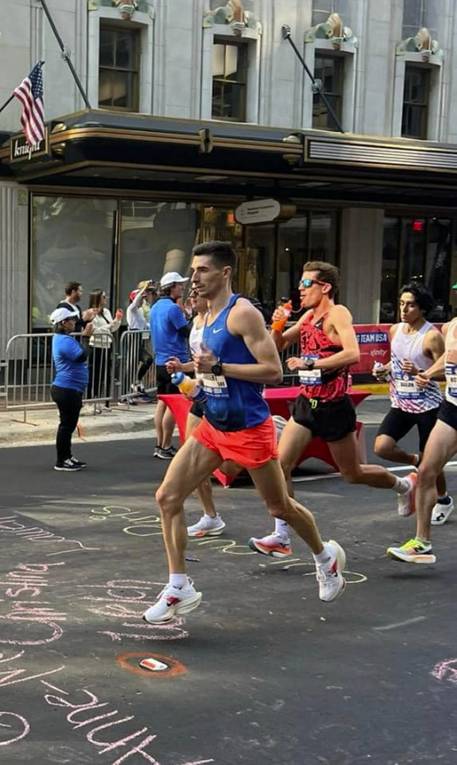
Dan looking strong competing in the 2024 U.S. Olympic Marathon Trials
Dan also enjoyed the camaraderie of the other runners. Rather than a cut throat, all for themselves approach, he was able to get into a pack with a good group of guys. They supported each other and seemed to make it their goal to get this whole collective group across the finish line. The guy closest to the sponges would pick up a bunch of them and hand them around. Nice to know that people can be competitive but yet still selfless.
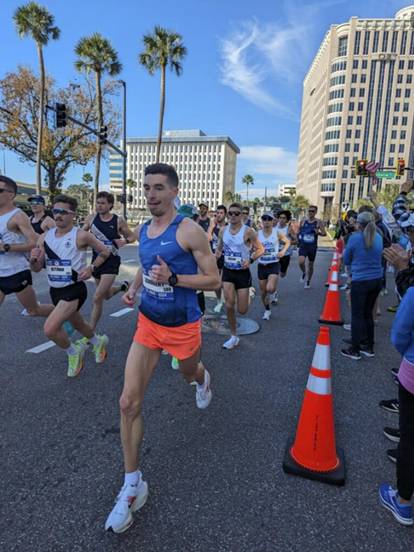
Dan also enjoyed the camaraderie of the other runners. Rather than a cut throat, all for themselves approach, he was able to get into a pack with a good group of guys. They supported each other and seemed to make it their goal to get this whole collective group across the finish line. The guy closest to the sponges would pick up a bunch of them and hand them around. Nice to know that people can be competitive but yet still selfless.
Although it wasn’t exactly the race experience that Dan had dreamed of he was very honored to participate in this event and takes away great life lessons. Only 150 of the 200 men finished and Dan was proudly one of them, finishing at 2:28:10. A 5:40/mile average pace still is awfully fast!
So what’s next for Dan? For now, he will take some time off from running and rid himself of his pains. Will he do another marathon in his future? Maybe. Would he repeat this experience in another 4 years if it presented itself? He would love to. He knows that running is too important for him to just stop doing it, that competitiveness will not just go away. But who knows where his life will take him. “I don’t want running to be the only thing that defines me.”
Whatever you decide Dan, you surely will be a success. Congratulations on your great accomplishments!
USING AGE GRADED RACE RESULTS (part 2)
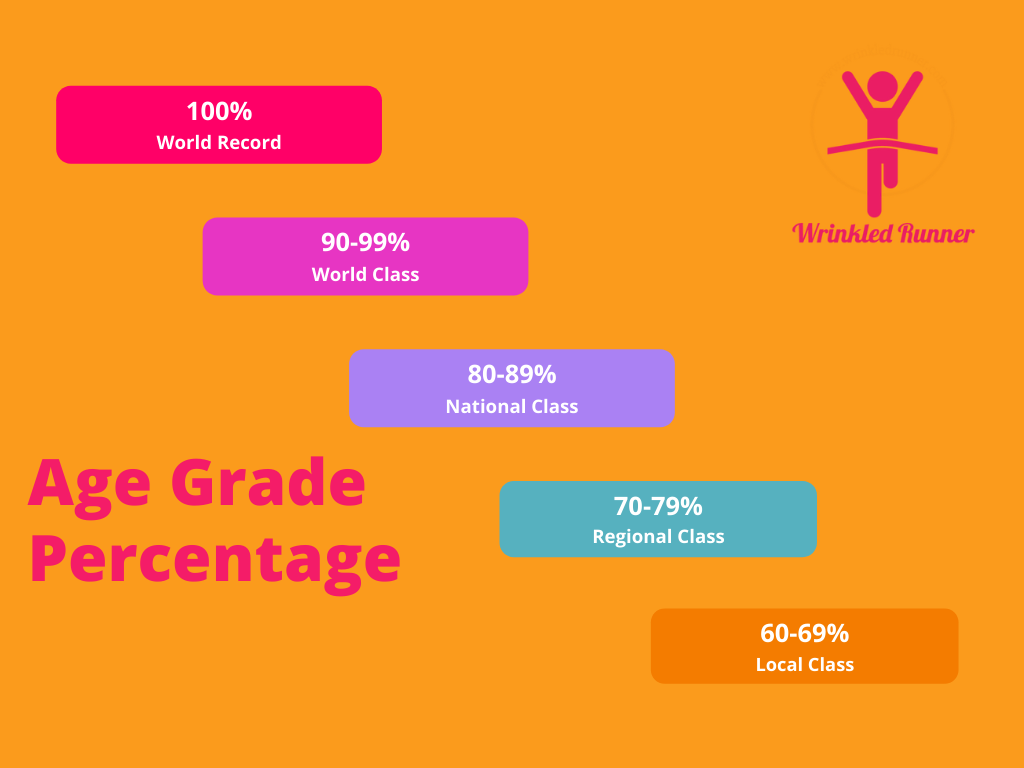
Last month we discussed what Age-Graded Scoring (AGS) means and how to use this as a good long term measuring stick throughout our lives. To repeat, your AGS score is a % of how close your race time is to the World Record time achieved for a person your age and gender for that distance.
Here is an example of how we can apply this tool and use it to compare your performance with men and women runners of different ages:
Let's say a 55-year old male runs a marathon in 3:00:27. He would receive an impressive Age-Graded Score of 80.21%. That is because, according to the AGS tables, the "ideal" World Record finish time for a 55-year old male is 2:24:22, which is about 20% (or about 36 minutes) faster than what our 55-year old man ran that day.
Now let's say that a 27-year old male ran the same marathon in 2:45:47. That sounds great and is obviously faster than our 55-year old. But is the performance of the younger runner really "better" when compared with that of a man more than twice his age? The answer is “No!” because the AGS of the 25-year old man is lower at 76.51%.
So the old guy wins! And, our 27-year old has a lot of training to do if he expects to "improve with age" and post anything close to a 3-hour marathon when he turns fifty-five!
If your race results website do not give you this Age-Graded Score data, here is a simple calculator you can use to generate your own score. AGS Calculator. If you've kept past race results, you may find it valuable to go back several years and enter those race times and corresponding ages to help you analyze how your performances have graded over time, and how your scores compare with your more recent races. You may think you did better in earlier races you did decades ago since you were faster but could find out you are actually running better today relative to your age. You can do these calculations whether you’re running a 5k or a marathon.
Or you might begin collecting your AGS’s starting fresh this year and to see how you do in future runs. You may find that even though your race times are getting slower, your AGS’s are remaining consistent or perhaps improving, meaning you're doing great!
Kiptum Tragically Killed in Auto Crash in his Kenyan Homeland
World Record Marathon holder Kelvin Kiptum, age 24, along with his training coach were tragically killed in an auto crash in Kenya this past month. Kiptum had recently made headlines around the world when he shattered the Marathon World Record completing the October 2023 Chicago Marathon in an astonishing 2:00:35 time (see PaceSetters November 2023 Newsletter).
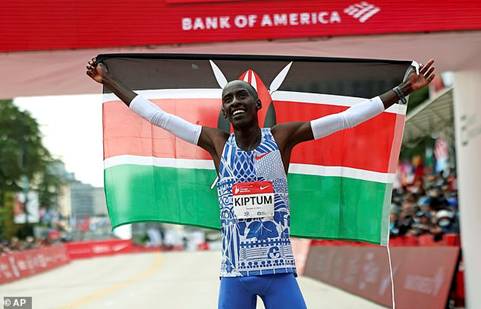
It was only his 3rd marathon, and at age 23 he had already recorded 3 of the 7 fastest marathon times ever. That is very young for an elite marathoner, the others on that list were at least 9 years older than him. Unlike other elites, he was already training 180 miles per week, or a marathon per day. He had publically stated his intention of breaking the sub-2:00 barrier this April at the Rotterdam Marathon, a time long thought to be unreachable.